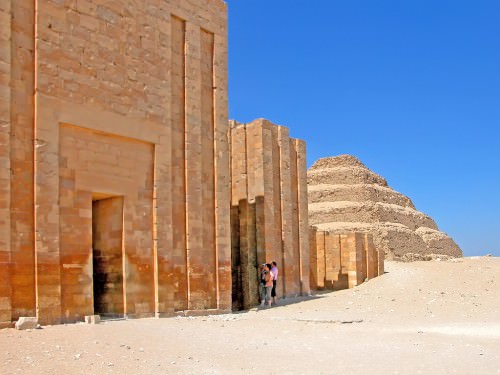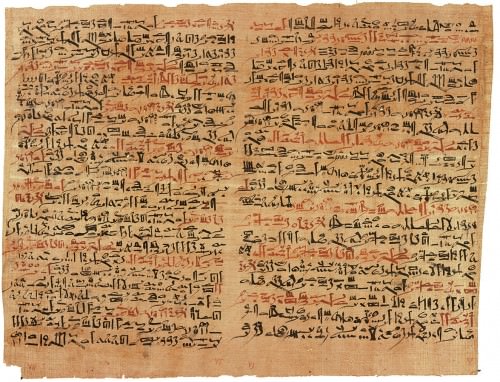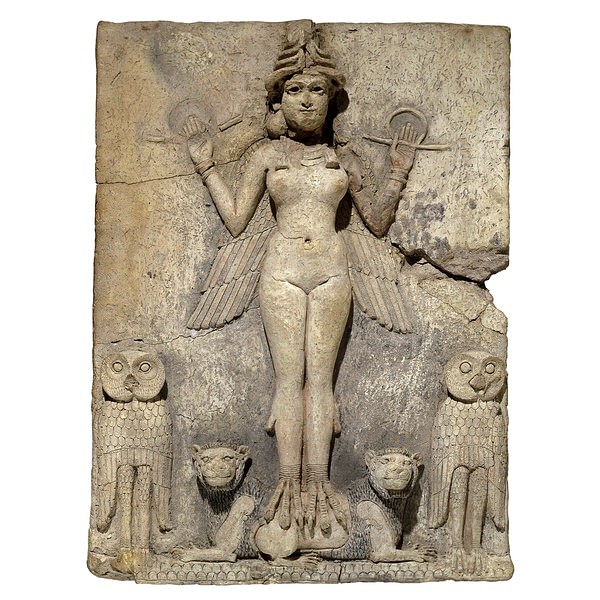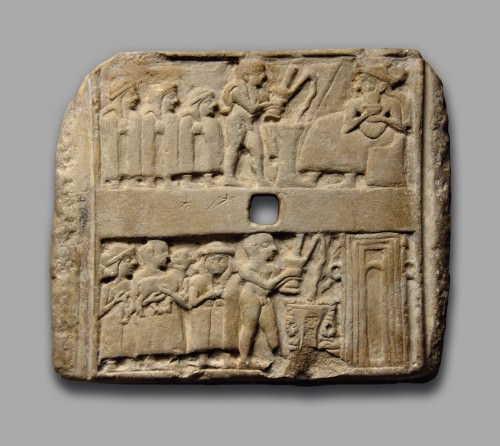Imhotep › Mesopotamian Religion » Ancient origins
Articles and Definitions › Contents
- Imhotep › Who Was
- Mesopotamian Religion › Antique Origins
Ancient civilizations › Historical and archaeological sites
Imhotep › Who Was
Definition and Origins

Imhotep ( Greek name, Imouthes, c. 2667-2600 BCE) was an Egyptian polymath (a person expert in many areas of learning) best known as the architect of King Djoser 's Step Pyramid at Saqqara. His name means "He Who Comes in Peace" and he is the only Egyptian besides Amenhotep to be fully deified, becoming the god of wisdom and medicine (or, according to some sources, god of science, medicine, and architecture). Imhotep was a priest, vizier to King Djoser (and possibly to the succeeding three kings of the Third Dynasty), a poet, physician, mathematician, astronomer, and architect.
Although his Step Pyramid is considered his greatest achievement, he was also remembered for his medical treatises which regarded disease and injury as naturally occuring instead of punishments sent by gods or inflicted by spirits or curses. He was deified by the Egyptians in c. 525 BCE and was equated with the demi-god of healing Asclepius by the Greeks. His works were still extremely popular and influential during the Roman Empire and the emperors Tiberius and Claudius both had their temples inscribed with praise of the benevolent god Imhotep.
DJOSER'S STEP PYRAMID
IMHOTEP WAS A COMMONER BY BIRTH WHO ADVANCED TO THE POSITION OF ONE OF THE MOST IMPORTANT AND INFLUENTIAL MEN IN EGYPT THROUGH HIS NATURAL TALENTS.
Under King Djoser's reign (c. 2670 BCE) Imhotep was vizier and chief architect. Throughout his life, he would hold many titles including First After the King of Upper Egypt, Administrator of the Great Palace, Chancellor of the King of Lower Egypt, Hereditary Nobleman, High Priest of Heliopolis, and Sculptor and Maker of Vases Chief. Imhotep was a commoner by birth who advanced to the position of one of the most important and influential men in Egypt through his natural talents.
He may have begun as a temple priest and was a very religious man. He became high priest of Ptah (and was known reverently as "Son of Ptah") under Djoser and, with his understanding of the will of the gods, was in the best position to oversee the construction of the king's eternal home. The early tombs of the kings of Egypt were mastabas, rectangular structures of dried mud bricks constructed over underground chambers where the dead were placed. When Imhotep began building the Step Pyramid he changed the traditional shape of the king's mastaba from a rectangular base to a square one.Why Imhotep decided to change the traditional shape is unknown but it is probable that he had in mind a square-based pyramid from the start.

Step Pyramid at Saqqara
The early mastaba was built in two stages and, according to Egyptologist Miroslav Verner, "a simple but effective construction method was used. The masonry was laid not vertically but in courses inclined toward the middle of the pyramid, thus significantly increasing its structural stability. The basic material used was limestone blocks, whose form resembled that of large bricks of clay (115-116)." The early mastabas had been decorated with inscriptions and engravings of reeds and Imhotep wanted to continue that tradition. His great, towering mastaba pyramid would have the same delicate touches and resonant symbolism as the more modest tombs which had preceded it and, better yet, these would all be worked in stone instead of dried mud. Historian Mark Van de Mieroop comments on this, writing :
Imhotep reproduced in stone what had been previously built of other materials. The facade of the enclosure wallhad the same niches as the tombs of mud brick, the columns resembled bundles of reed and papyrus, and stone cylinders at the lintels of doorways represented rolled-up reed screens. Much experimentation was involved, which is especially clear in the construction of the pyramid in the center of the complex. It had several plans with mastaba forms before it became the first Step Pyramid in history, piling six mastaba-like levels on top of one another...The weight of the enormous mass was a challenge to the builders, who placed the stones at an inward incline in order to prevent the monument breaking up (56).
When completed, the Step Pyramid rose 204 feet (62 meters) high and was the tallest structure of its time. The surrounding complex included a temple, courtyards, shrines, and living quarters for the priests covering an area of 40 acres (16 hectares) and surrounded by a wall 30 feet (10.5 meters) high. The wall had 13 false doors cut into it with only one true entrance cut in the south-east corner; the entire wall was then ringed by a trench 2,460 feet (750 meters) long and 131 feet (40 meters) wide.Historian Margaret Bunson writes:
Imhotep built the complex as a mortuary shrine for Djoser, but it became a stage and an architectural model for the spiritual ideals of the Egyptian people. The Step Pyramid was not just a single pyramidal tomb but a collection of temples, chapels, pavillions, corridors, storerooms, and halls. Fluted columns emerged from stone according to his plan. Yet he made the walls of the complex conform to those of the palace of the king, according to ancient styles of architecture, thus preserving a link with the past (123).
Djoser was so impressed by Imhotep's creation that he disregarded the ancient precedent that only the king's name appear on his monuments and had Imhotep's name inscribed as well. When Djoser died, he was placed in the burial chamber beneath the Step Pyramid and Imhotep is thought to have gone on to serve his successors, Sekhemkhet (c. 2650 BCE), Khaba (c. 2640 BCE), and Huni (c. 2630-2613 BCE). Scholars disagree on whether Imhotep served all four kings of the Third Dynasty but evidence suggests he lived a long life and was much sought after for his talents.
THIRD DYNASTY PYRAMIDS
Imhotep may have been involved in the design and construction of the pyramid and complex of Sekhemkhet which archaeologists believe was originally intended to be greater than Djoser's. The pyramid was never completed because Sekhemkhet died in the sixth year of his reign, but the base and first level show similarities in design to Imhotep's work on Djoser's pyramid.
Sekhemkhet was succeeded by Khaba who commissioned his own pyramid, now known as the Layer Pyramid, which was also left unfinished when Khaba died. The Layer Pyramid is also similar in design to Djoser's monument, especially in the square base for the foundation and the technique of building inwards toward the middle of the structure instead of upwards.Whether the Layer Pyramid and Buried Pyramid were designed by Imhotep himself or based on his designs is not known.There are scholars who argue in favor of Imhotep's personal hand in the later pyramids and others who challenge that claim.As both sides of the debate point to the same evidence, and nothing new has emerged to tip the scales, the matter remains unresolved. Imhotep is thought to have also served the last king, Huni, but as little is known of Huni's reign, this claim remains speculative. Huni was once thought to have built his own pyramids but now those have been positively identified with other kings.
MEDICAL CONTRIBUTIONS
Imhotep was practicing medicine and writing on the subject 2,200 years before Hippocrates, the Father of Modern Medicine, was born. He is generally considered the author of the Edwin Smith Papyrus, an Egyptian medical text, which contains almost 100 anatomical terms and describes 48 injuries and their treatment. The text may have been a military field manual and dates to c. 1600 BCE, long after Imhotep's time, but is thought to be a copy of his earlier work.

Edwin Smith Papyrus
The Edwin Smith Papyrus is so named for the collector who purchased it from an antiquities dealer in 1862 CE. It is written in hieratic script, the cursive shorthand of Egyptian hieroglyphics. The most interesting aspect of the work is the modern approach it has to treating injuries. Unlike many medical texts of the ancient world, there is little recourse to magical treatments in the Edwin Smith Papyrus. Every injury is described and diagnosed rationally with a following treatment, prognosis, and explanatory notes. This is not to say there is no allusion to medical practices commonly used at the time; the reverse side of the papyrus features eight magic spells and chants for healing.
Examinations are described along the same lines as a modern-day visit to a doctor. Patients are asked where they are injured/feel pain, the physician then addresses the wound by touching or prodding and questioning the patient. The prognosis given after every entry begins with the phrases "An ailment I will handle" or "An ailment I will fight with" or "An ailment for which nothing can be done" which, according to the US National Library of Medicine's article on the subject, "could be seen as the earliest form of medical ethics as an ancient physician would generally refuse to treat a condition he knew was fatal." The National Library article goes on to observe that these prognoses could also have served as a kind of insurance "when a poor outcome is expected" and would have helped save a physician's reputation if treatment failed to cure the patient.
LEGACY
A number of didactic writings on morality and religion, as well as poetry, scientific observations, and architectural treatises are also attributed to Imhotep but have not survived; they are referenced in later writers' works. Regarding his masterpiece, the Step Pyramid, Miroslav Verner writes:
Few monuments hold a place in human history as significant as that of the Step Pyramid in Saqqara...It can be said without exaggeration that his pyramid complex constitutes a milestone in the evolution of monumental stone architecture in Egypt and in the world as a whole. Here limestone was first used on a large scale as a construction material, and here the idea of a monumental royal tomb in the form of a pyramid was first realized.In a Nineteenth Dynasty inscription found in South Saqqara, the ancient Egyptians were already describing Djoser as 'the opener of stone', which we can interpret as meaning the inventor of stone architecture (108-109).
The innovations attributed to Djoser were actually initiated by Imhotep following his vision to build a colossal monument entirely of stone. He was able to imagine a feat never attempted before, perhaps never even conceived of, and make it a reality; in doing so, he changed the world. The great temples and administrative buildings, palaces and tombs, the majestic monuments of the pyramids and towering statuary which came to define the Egyptian landscape, all began with Imhotep's vision of the Step Pyramid at Saqqara. Once a monument built of stone had been accomplished, it could be attempted again and then again with greater attention to detail and improvement in technology to create the "true pyramids" of Giza. Further, visitors to Egypt who saw these immense creations brought back reports of them to their own countries, such as Greece, who then built upon what Imhotep had first imagined and then made real.
Mesopotamian Religion › Antique Origins
Definition and Origins

In ancient Mesopotamia, the meaning of life was for one to live in concert with the gods. Humans were created as co-laborers with their gods to hold off the forces of chaos and to keep the community running smoothly.
MESOPOTAMIAN CREATION MYTH
According to the Mesopotamian creation myth, the Enuma Elish, (meaning,'When on High') life began after an epic struggle between the elder gods and the younger. In the beginning there was only water swirling in chaos and undifferentiated between fresh and bitter. These waters separated into two distinct principles: the male principle, Apsu, which was fresh water and the female principle, Tiamat, salt water. From the union of these two principles all the other gods came into being.
These younger gods were so loud in their daily concourse with each other that they came to annoy the elders, especially Apsu and, on the advice of his Vizier, he decided to kill them. Tiamat, however, was shocked at Apsu's plot and warned one of her sons, Ea, the god of wisdom and intelligence. With the help of his brothers and sisters, Ea put Apsu to sleep and then killed him. Out of the corpse of Apsu, Ea created the earth and built his home (though, in later myths 'the Apsu' came to mean the watery home of the gods or the realm of the gods).
Tiamat, upset now over Apsu's death, raised the forces of chaos to destroy her children herself. Ea and his siblings fought against Tiamat and her allies, her champion, Quingu, the forces of chaos and Tiamat's creatures, without success until, from among them, rose the great storm god Marduk. Marduk swore he would defeat Tiamat if the gods would proclaim him their king. This agreed to, he entered into battle with Tiamat, killed her and, from her body, created the sky. He then continued on with the act of creation to make human beings from the remains of Quingu as help-mates to the gods.
According to historian D. Brendan Nagle:
Despite the gods' apparent victory, there was no guarantee that the forces of chaos might not recover their strength and overturn the orderly creation of the gods. Gods and humans alike were involved in the perpetual struggle to restrain the powers of chaos, and they each had their own role to play in this dramatic battle. The responsibility of the dwellers of Mesopotamian cities was to provide the gods with everything they needed to run the world.
CITIES, TEMPLES, AND GODS
The gods, in turn, took care of their human helpers in every aspect of their lives. From the most serious concerns of praying for continued health and prosperity to the simplest, the lives of the Mesopotamians revolved around their gods and so, naturally, the homes of the gods on earth: the temples.
THE MOST FAMOUS HOLY CITY WAS NIPPUR WHERE THE GOD ENLIL LEGITIMIZED THE RULE OF KINGS.
Every city had, as its center, the temple of the patron god of that city. The most famous holy city was Nippur where the god Enlil legitimized the rule of kings and presided over pacts. So important a center was Nippur that it survived, intact, into the Christian and then the Muslim periods and continued, until 800 CE, as an important religious center for those new faiths.
The patron god or goddess of a city had the largest temple in the city, but there were smaller temples and shrines to other gods throughout. The god of a particular temple was thought to literally inhabit that building and most temples were designed with three rooms, all heavily ornamented, the innermost being the room of the god or goddess where that deity resided in the form of his or her statue. Every day the priests of the temple were required to tend to the needs of the god. According to Nagle:
“Daily, to the sound of music, hymns, and prayers, the god was washed, clothed, perfumed, fed and entertained by minstrels and dancers. In clouds of incense, meals of bread, cakes, fruit and honey were set before the deity, along with offerings of beer, wine and water…On feast days the statues of the deities were taken in solemn procession through the courtyard [and] the streets of the city accompanied by singing and dancing.”
The gods of every city were accorded this respect and, it was believed, they needed to make the rounds of the city at least once a year in the same way a good ruler would ride out from his palace to inspect his city regularly.

Foundation Figurine of Ur-Nammu
The gods could even visit each other on occasion as in the case of the god Nabu whose statue was carried once a year from Borsippa to Babylon to visit his father Marduk. Marduk, himself, was honored greatly in this same way at the New Year Festival in Babylon when his statue was carried out of the temple, through the city, and to a special little house outside the city walls where he could relax and enjoy some different scenery. Throughout this procession, the people would chant the Enuma Elish in honor of Marduk's great victory over the forces of chaos.
MESOPOTAMIAN UNDERWORLD
The Mesopotamians not only revered their gods but also the souls of those who had gone on to the underworld. The Mesopotamian paradise (known as "Dilmun" to the Sumerians ) was the land of the immortal gods and was not given the same sort of attention the underworld received. The Mesopotamian underworld, where the souls of departed humans went, was a dark and dreary land from which no one ever returned but, even so, a spirit who had not been honored properly in burial could still find ways to inflict misery on the living.
As the dead were often buried under or near the home, each house had a small shrine to the dead inside (sometimes a 'chapel' built on to the existing homes of the more affluent, as seen at Ur ) where daily sacrifices of food and drink were made to the spirits of the departed. If one had done one's duty to the gods and others in the community, but still suffered some unfortunate fate, a Necromancer was consulted to see if perhaps one had offended the spirits of the dead in some way.
The famous Babylonian poem Ludlul bēl nēmeqi of 1700 BCE (known as "the Sumerian Job" owing to its similarity to the Biblical Book of Job ) makes mention of this when the speaker, Tabu-Utul-Bel (known in Sumerian as Laluralim) in questioning the cause of his suffering, says how he consulted the Necromancer, “but he opened not my understanding.” Like the Book of Job, the Ludlul bēl nēmeqi asks why bad things happen to good people and, in Laluralim's case, asserts that he did nothing to offend fellow man, gods or spirits to merit the misfortune he is suffering.
DIVINATION
Divination was another important aspect of Mesopotamian religion and was developed to a high degree. A clay model of a sheep's liver, found at Mari, indicates in great detail how a Diviner was to go about interpreting the messages found in that organ of the sheep. To the Mesopotamians, divination was a scientific method of interpreting and understanding the messages from the gods in earthly contexts. If a certain type of bird acted in an unusual way it could mean one thing, while if it acted in another, the gods were saying something different.
A man suffering with certain symptoms would be diagnosed by a diviner in one way while a woman with those same symptoms in another, depending on how the diviner read the signs presented. The great rulers of the land had their own special diviners (as later kings and generals would have their personal doctors) while the less affluent had to rely on the care provided by the local diviner.

A Sumerian Wall Plaque Showing Libation Scenes
INFLUENCE OF MESOPOTAMIAN MYTHS
The people of Mesopotamia relied on their gods for every aspect of their lives, from calling on Kulla, the god of bricks, to help in the laying of the foundation of a house, to petitioning the goddess Lama for protection, and so developed many tales concerning these deities. The myths, legends, hymns, prayers and poems surrounding the Mesopotamian gods and their interaction with the people introduced many of the plots, symbols and characters which modern-day readers are acquainted with such as
- the story of the Fall of Man ( The Myth of Adapa ),
- the tale of the Great Flood ( The Atrahasis ),
- the Tree of Life ( Inanna and the Hulappu Tree ),
- the tale of a wise man/prophet taken up to heaven ( The Myth of Etana ),
- the story of creation ( The Enuma Elish ),
- the quest for immortality ( The Epic of Gilgamesh ),
- the Dying and Reviving god figure (a deity who dies or goes into the underworld and returns to life or the surface of the world to in some way benefit the people) who is famously depicted through Inanna's Descent to the Underworld.
These tales, among many others, became the basis for later myths in the regions the Mesopotamians traded and interacted with, most notably the land of Canaan ( Phoenicia ) whose people, in time, would produce the narratives which now comprise the scriptures known as the Old and New Testaments of the Bible.
LICENSE:
Article based on information obtained from these sources:with permission from the Website Ancient History Encyclopedia
Content is available under License Creative Commons: Attribution-NonCommercial-ShareAlike 3.0 Unported. CC-BY-NC-SA License